2014 FIFA World Cup
From Wikipedia, the free encyclopedia
| Copa do Mundo da FIFA Brasil 2014 | |
|---|---|
 2014 FIFA World Cup logo | |
| Tournament details | |
| Host country | |
| Dates | 13 June – 13 July |
| Teams | 32 (from 6 confederations) |
| Venue(s) | 12 (in 12 host cities) |
← 2010
2018 →
| |
This will be the second time the country has hosted the competition, the first being the 1950 FIFA World Cup. Brazil will become the fifth country to have hosted the FIFA World Cup twice, after Mexico, Italy, France and Germany. It will be the first World Cup to be held in South America since the 1978 FIFA World Cup in Argentina, the first time two consecutive World Cups are staged outside Europe and the first time two consecutive World Cups are staged in the Southern Hemisphere (the 2010 FIFA World Cup was held in South Africa).
Contents[hide] |
[edit] Host selection
Main article: 2014 FIFA World Cup bid process
Brazil formally declared its candidacy in December 2006 and Colombia followed a few days later. The Argentina bid never materialized. On 11 April 2007, Colombia officially withdrew its bid, Francisco Santos Calderón the vice president of Colombia announced that instead Colombia would be hosting the 2011 FIFA U-20 World Cup. With this development, Brazil became the only official candidate to host the 2014 event.[3] Brazil won the right to host the event on 30 October 2007 as the only country to enter a bid.[4]
[edit] Qualification
Main article: 2014 FIFA World Cup qualification
The qualification draw for the 2014 World Cup will be held at the Marina da Glória in Rio de Janeiro on 30 July 2011.[5] As the host nation, Brazil qualify automatically for the tournament.On 3 March 2011 FIFA decided to distribute places in the final tournament[6]:
- Europe (UEFA) - 13 places
- Asia (AFC) - 4 guaranteed places + 1 place in play-off
- Africa (CAF) - 5 places
- North America, Central America and the Caribbean (CONCACAF) - 3 guaranteed places + 1 place in play-off
- South America (CONMEBOL) - 4 guaranteed places + 1 place in play-off + Brazil qualified as host nation
- Oceania (OFC) - 1 place in play-off
[edit] Qualified teams
Team | Order of qualification  | Method of qualification  | Date of qualification  | Finals appearance  | Consecutive World Cups  | Last appearance  | Previous best performance  | FIFA Ranking at start of event  |
|---|---|---|---|---|---|---|---|---|
| 1st | Host | 30 Oct 2007 | 20th | 20 | 2010 | Winner (1958, 1962, 1970, 1994, 2002) |
[edit] Venues
Seventeen cities showed interest in being chosen as World Cup host cities: São Paulo, Rio de Janeiro, Belo Horizonte, Porto Alegre, Brasília, Belém, Campo Grande, Cuiabá, Curitiba, Florianópolis, Fortaleza, Goiânia, Manaus, Natal, Recife (a stadium would be shared by both cities), Rio Branco and Salvador.[7] Maceió withdrew in January 2009.According to current FIFA practice, no more than one city may use two stadiums, and the number of host cities is limited between eight and ten. The Brazilian Football Confederation (CBF) requested permission to assign 12 cities hosting World Cup Finals.[8] On 26 December 2008, FIFA gave the green light to the 12-city plan.[9]
Even before the 12 host cities were selected, there were few doubts that the chosen venue for the final match will be the Maracanã in Rio de Janeiro, which also hosted the decisive match of the 1950 FIFA World Cup. Originally the CBF's intentions were to have the opening match at Estádio do Morumbi in São Paulo, the largest city in Brazil. However, on 14 June 2010 the stadium was excluded from hosting games in the tournament due to a failure to provide financial guarantees for the improvements needed to have it as an eligible venue.[10] In the end of August 2010, the CBF announced that the new Corinthians stadium will host the matches in São Paulo.
The 12 host cities for the 2014 World Cup were announced on 31 May 2009.[11] Belém, Campo Grande, Florianópolis, Goiânia and Rio Branco were rejected.
| Belo Horizonte | Brasília | Cuiabá | Curitiba |
|---|---|---|---|
| Mineirão | Estádio Nacional de Brasília | Arena Pantanal | Arena da Baixada |
| Planned capacity: 69,950 (upgraded) | Planned capacity: 71,500 (upgraded) | Planned capacity: 42,500 (new stadium) | Planned capacity: 41,375 (upgraded) |
 | 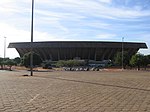 | 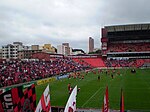 | |
| Fortaleza | Manaus | ||
| Castelão | Arena Amazonia | ||
| Planned capacity: 66,700 (upgraded) | Planned capacity: 50,000 (new stadium) | ||
| Natal | Porto Alegre | ||
| Arena das Dunas | Estádio Beira-Rio | ||
| Planned capacity: 45,000 (new stadium) | Planned capacity: 62,000 (upgraded) | ||
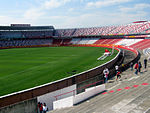 | |||
| Recife | Rio de Janeiro | Salvador | São Paulo |
| Cidade da Copa | Maracanã | Bahia Arena | New Corinthians Stadium |
| Planned capacity: 46,160 (new stadium) | Planned capacity: 76,525 (upgraded) [12] | Planned capacity: 55,000 (new stadium) | Planned capacity: 48,000 (new stadium) [13] |
 | |||
[edit] Logo
The logo is called "Inspiration", and was created by Brazilian agency Africa. The design stems from an iconic photograph of three victorious hands together raising the world's most famous trophy. As well as depicting the humanitarian notion of hands interlinking, the portrayal of the hands is also symbolic of the yellow and green of Brazil warmly welcoming the world to their country. The logo was unveiled at a ceremony held in Johannesburg on 8 July 2010.[14]FIFA and the Brazil LOC invited 25 Brazilian-based agencies to submit designs for the Official Emblem of the 2014 tournament and the task of picking the winner was awarded to a high-profile seven-strong judging panel consisting of CBF chairman Ricardo Teixeira, FIFA executive secretary Jérôme Valcke, supermodel Gisele Bündchen, architect Oscar Niemeyer, writer Paulo Coelho, singer Ivete Sangalo, and designer Hans Donner.[15]
Brazilian graphic designer Alexandre Wollner has criticized the design, suggesting it resembles a hand covering a face in shame, and the process through which it was chosen, having a jury that excluded professional graphic designers.[16]
[edit] Infrastructure
The CBF estimates that the cost of construction and remodeling of stadiums[17] alone will be approximately over R$ 1.9 billion (US$ 1.1 billion, £ 550 million).[18] In addition to the stadium upgrades and renovations, there will be millions more spent on basic infrastructure needs to get the country ready.When informed of the decision to host the tournament, CBF President Ricardo Teixeira said: "We are a civilized nation, a nation that is going through an excellent phase, and we have got everything prepared to receive adequately the honor to organize an excellent World Cup." Teixeira was on hand at FIFA's headquarters in Zürich when the announcement was made.
"Over the next few years we will have a consistent influx of investments. The 2014 World Cup will enable Brazil to have a modern infrastructure," Teixeira said. "In social terms will be very beneficial. Our objective is to make Brazil become more visible in global arenas," he added. "The World Cup goes far beyond a mere sporting event. It's going to be an interesting tool to promote social transformation."
In September 2008, Brazil's Ministry of Transport announced a high-speed rail project for the World Cup connecting Campinas, São Paulo and Rio de Janeiro. This would cost R$11 billion (approx. US$ 6.25 billion, £ 4.1 billion).[19] The technology will most likely be provided by companies from France, Japan, South Korea or Germany which will form consortia with Brazilian engineering firms. However, on 2 July 2010, it was announced that the line is now not expected to open before late-2016.[20]
On 31 August 2009 the state airport management agency Infraero unveiled a R$ 5.3 billion (approx. US$ 3 billion, £ 2 billion) investment plan[21] to upgrade airports of ten of the venue cities, increasing their capacity and comfort for the hundreds of thousands of tourists expected for the Cup. Natal and Salvador are excluded because their upgrade works have been recently completed. A significant amount (55.3%) of the money will be spent overhauling the airports of São Paulo and Rio de Janeiro. The investment figure covers works to be carried out up to 2014.
The announcement by Infraero came in reply to criticism made by the Brazilian General Aviation Association, a grouping of private aircraft owners, that Brazil's airports currently could not cope with the World Cup inflow. The vice-president of the association, Adalberto Febeliano, told reporters that more than 500,000 football fans were expected, with each one taking between six and fourteen flights during the tournament to get to the games in various cities.[22]
The majority of Brazil's airports were built before the end of World War II, and several were at saturation point in terms of passengers, according to the association. It added that it should be possible to renovate the facilities "within three or four years" if the political will exists. Infraero said in a statement: "In the race against time, Infraero is making sure that the sixty-seven airports in its network are in perfect condition and can welcome in comfort and security passengers in Brazil and from abroad." In May 2010, the Government of Brazil changed the bidding legislation to allow more flexibility to Infraero.[23]
[edit] Development programme
The Brazilian federal government has earmarked R$ 3 billion (US$ 1.8 billion, £ 1.1 billion) for investment in works relating to the 2014 World Cup, and intends to release a package of works, entitled the FIFA World Cup PAC (Portuguese acronym for Growth Acceleration Programme). According to the Brazilian minister of cities, Márcio Fortes, the bulk of funds should go to works pertaining to the tournament itself, but the total figure will only be defined after a meeting with representatives of the municipalities that will host the matches."This is only an initial figure. We have not set a figure yet. These R$3 billion will allow us to take the first step. The total value of projects is not known yet. We are going to hold talks with mayors to learn which projects are priorities," said the minister. The funds will be supplied by Pró-Transporte, a financing programme funded by the Severance Pay Indemnity Fund (FGTS) whose regulation was passed last year by the fund's Board of Curators.
According to Fortes, several city councils have already contacted the ministry and showed interest in partnership for carrying out infrastructure work turned exclusively to the Cup that will be held in Brazil. "For some time now, the city councils that will host the matches have been contacting us. The city councils have had meetings with FIFA and several projects were outlined. Our approach consists of dealing only with projects exclusively turned to the Cup. Our goal right now is not to solve transport-related issues in the city. We are going to help solve the issues pertaining to the events," he stated. According to the minister, another factor to be analysed by the Ministry of Cities is usefulness and sustainability of the investment after the competition is over. "We are not going to deal with huge projects. The cheapest and most efficient means of transport will be used. Of course, each case will be analysed separately," he explained.
The minister also informed that preparations for the World Cup already include the creation of a line of financing for renewing the bus fleet across the country. The line will be made available by the Brazilian Federal Savings Bank with total funds of R$1 billion (US$ 600 million, £ 375 million).[24]
[edit] Maracanã projects
The project may also provide for the restoration of the Quinta da Boa Vista and the Museum of de São Cristóvão, in addition to redevelopment and revitalization of neighborhoods including Tijuca. The Engenhão stadium, completed for the 2007 Pan American Games, has a capacity of 45,000 people and will serve as a training ground for the World Cup.
An investment of R$ 5 billion is required to meet the requirements that Rio de Janeiro faces in the final tournament and other games, covering three areas: logistics (roads, railways, ports, waterways and airports), energy (generation and transmission of electric power, petroleum, natural gas and renewables) and social and urban (light, sanitation, housing, subways and water resources). In relation to the Rio de Janeiro Metro, the Ministry of Transport has held a public hearing regarding the extension of its lines. The line for the new project is 13.5 km (8.4 mi) long, and should cross the South Zone of the city, carrying around 200,000 passengers per day between six metro stations.[25]
[edit] Host cities
| Region | 1950 | 2014 | Host cities in 1950 and 2014 | Host cities in 2014 only |
|---|---|---|---|---|
| Central-West | 0 | 2 | — | Brasília, Cuiabá |
| North | 0 | 1 | — | Manaus |
| Northeast | 1 | 4 | Recife | Fortaleza, Natal, Salvador |
| South | 2 | 2 | Curitiba, Porto Alegre | |
| Southeast | 3 | 3 | Belo Horizonte, Rio de Janeiro, São Paulo | |
A reported US$1 billion (approx. £650 million) is to be approved for the repair, upgrading and maintenance of Brazilian stadiums. However, aiming to build "state of the art" stadiums and, therefore, increasing their chances to be part of 2014's tournament, some Brazilian states are searching for expertise abroad. Recently delegations from Recife and Porto Alegre, for example, visited the Amsterdam Arena in order to understand the formula which made that stadium highly profitable. Amsterdam Arena, the home of AFC Ajax, has developed and is offering its expertise on the multi-use-purpose stadium concept and management. Amsterdam Arena has been developed to accommodate not only football matches but also concerts and events. Amsterdam Arena is currently developing two projects for Brazil: Recife/Olinda and Porto Alegre (Grêmio).[30]
[edit] Anti-fraud plan
On 11 June 2010, the federal government launched a program to protect the tenders for work in preparation for the 2014 World Cup and the 2016 Olympic Games against the possibility of fraud. The plan, known as Jogando Limpo (Playing It Clean), includes a series of guidelines and nuggets of advice so that the government institutions, and also the tax authorities and common citizens themselves, may identify and denounce attempts at fraud against the tenders. The program, which was launched by the Ministries for Justice and for Sport, also plans the establishment of a group dedicating to monitoring tenders, to protect them against the threat of fraud and also to avoid delays in construction work.This initiative, also boosted by the General Financial Controller of the Union (Controladoria Geral da União), also plans a campaign to make the people aware of the need to pay attention to possible fraud and to always denounce the cases. The program emphasizes measures against cartels and possible agreements between competing companies to set prices above market levels, in an attempt to raise the value of the contracts with the state. "Nothing can be worse than someone taking advantage of these two great opportunities to commit crimes. This is a world phenomenon," said the Minister for Justice, Luiz Paulo Barreto, during the ceremony to launch the program.
"The businesspeople could be entering with an agreement on prices, in order to compete in these tenders. This is something that needs to be tackled. We need to promote fair play also in our tenders," Barreto added. "Fair play is something we would expect from a country intending to host events of this size," he added. Barreto also said that, between 2007 and 2010, there were a total of 265 search and seizure warrants issued in Brazil to tackle the crime of cartel formation. In the same period over 100 people were preventively arrested for the same crime, and currently an additional 251 people are being investigated.[31]
[edit] Tax breaks
In addition, the 12 cities that shall be hosting the World Cup matches shall be able to grant exemption from State Value Added Tax (Imposto sobre Circulação de Mercadorias e Serviços - ICMS) on all operations involving merchandise and other goods for the construction or the refurbishment of the stadiums. "Conditional on the cumulative concession of the benefits involving Importation Tax, IPI and PIS/COFINS, the exemption of ICMS on imports shall only be applicable if the goods do not have a similar product produced nationally," the note informed, adding that this decision shall be made feasible through a Law or Provisional Measure.
In September 2009, the Brazilian Development Bank (Banco Nacional de Desenvolvimento Econômico e Social - BNDES) opened a credit line of R$ 4.8 billion (approx. US$ 2.7 billion, £ 1.75 billion) for the World Cup stadiums. Each host city shall be able to finance up to R$ 400 million (approx. US$ 225 million, £ 145 million) or 75% of the project, with bank funds.[32]


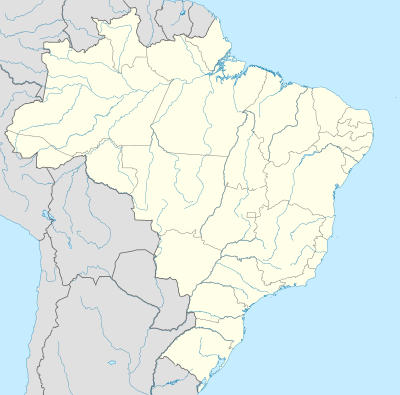
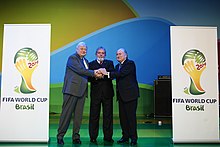






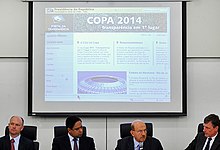

Tidak ada komentar:
Posting Komentar